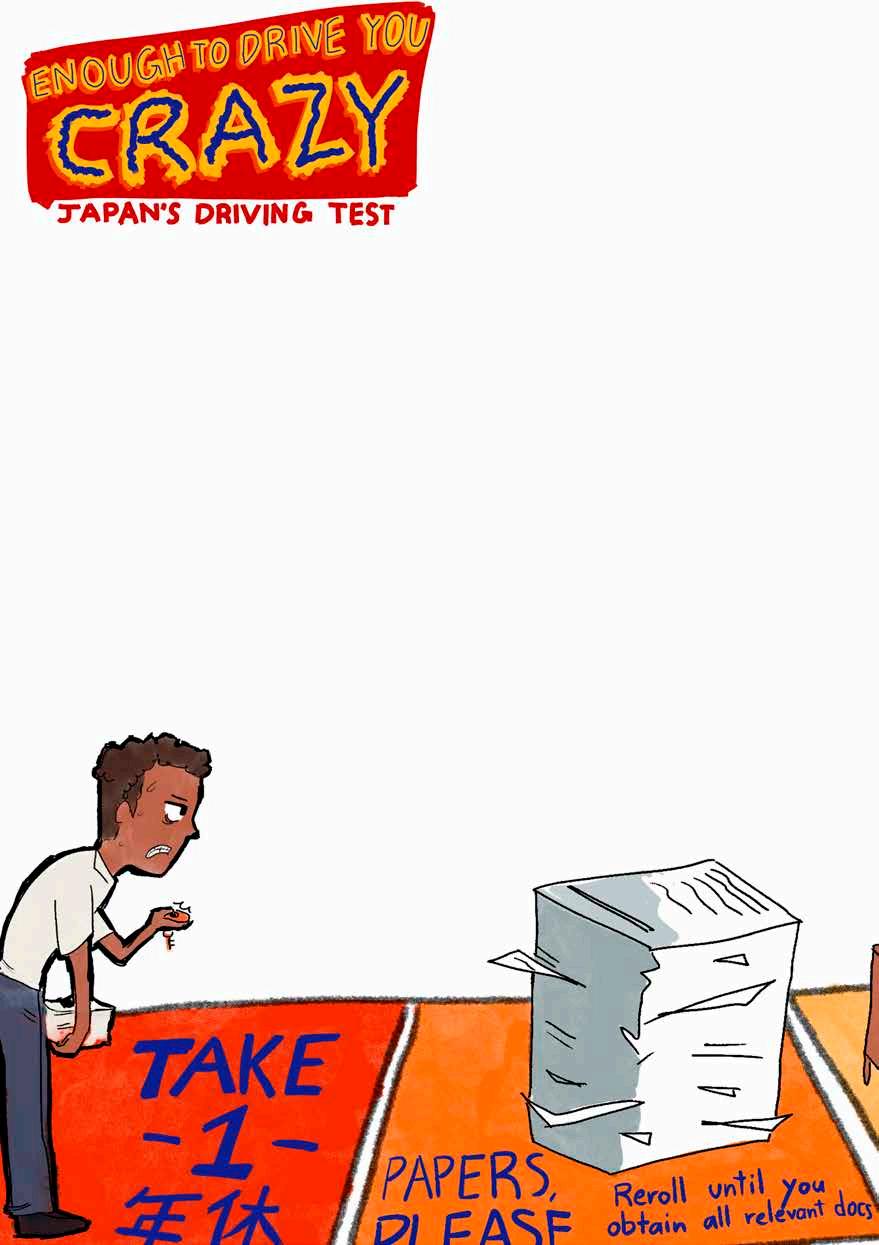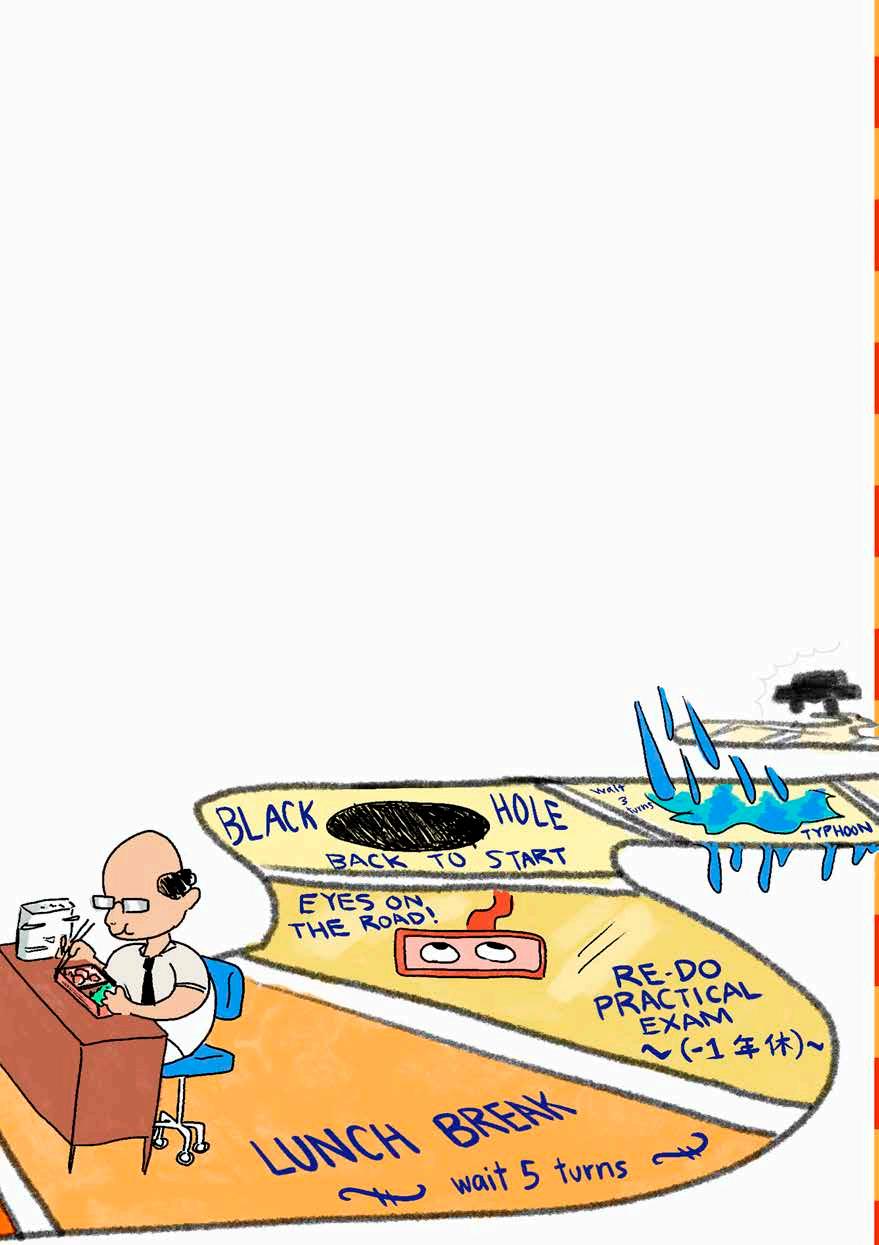
4 minute read
Japan's driving test: enough to drive you crazy
Driving in Japan is easy—at first. If you came to the country with an international driving permit, you are allowed to drive here for up to a year. However, once over, you must then convert your license into a Japanese li- cense. If you count yourself among one of the unfortunate nationalities like folks from the US or South Africa, then you will need to take a “practical exam.” It is a driving exam, which is, in my experience, anything but practical. This article is meant to shed some light on what is known to be an exasperating process, and share some pointers along the way. The two months during which I un- derwent the license conversion process were among my worst in Japan. Nothing prepared me for the reality of converting my license in Nagasaki. There were guides, of course, and I followed their instructions to the letter. I gathered up all of the necessary documents and practiced for the test. Even so, the process was an absolute nightmare. Every situation is different, but with bureaucracy, unfortu- nately, some things never change.
The prefectural driving center is located in Omura. Dwelling inside the center’s drab, gray exterior is a cult of ex- tremists Their main tenets are not believ- ing in modern technology or forgiveness. You will learn this firsthand when faxing file after file into an abyss. You will come to grips with this after mailing countless documents addressed to a brick wall and waiting up to two weeks for a simple reply. And after waiting? More often than not there is a problem. Sometimes, the tax returns going back ten years without gaps aren’t enough to prove you lived in your home country. Sometimes, your passport scan couldn’t be printed from a 4K Ultra HD image, so the clerk can’t tell for sure that it wasn’t forged. In short, if the office wants to give you a hard time, they can and they will. Thus, what should be a simple process can take a month or more to complete. Start the pro- cess early. Following documentation is the written exam. This happens to be the eas- iest part. Review the rules of the road and you should be fine. The test consists of ten common sense questions in English, which you can finish in about ten minutes. The issue is waiting for up to an hour to hear your score. You will get very good at wait- ing at the center. Bring something to pass the time. In my personal experience, the time of day changes little about how long you will wait. Is the center busy with peo- ple? Are they packed into corners and climbing atop vending machines to find somewhere to sit? You’re looking at an hour. Is the place empty save for a few teens reading manga and an old man drooling in his sleep? Congratulations. You’re looking at two hours.
Advertisement
Why? This is one of the biggest mysteries of bureaucracy in Japan. What are they doing that requires so much time to see a single customer? Could it be faxing phone books to Russia or copying papers with charcoal etchings? Beats me. Upon passing, you will be called on to take the practical test (if necessary). A staff member will hand you a map of the day’s course and a scoring sheet. They will give you a basic explanation about what to expect in Japanese and note that at 12 pm, you are permitted to walk the course by foot. This is highly recommended if you want to pass your first time. Learn the course. If you fail, then you must come back to the center on a different day to take the test again. “But I can already drive, the test should be easy!” you might say. From a logi- cal perspective, assuming you are not prone to bi-weekly car accidents, this is true. You have already proven that you can drive in Japan by sheer virtue of having already driven here for an entire year. But the truth is, your proctor couldn't care less about your driving skills. The test does not meas- ure how well you can drive. The test is to see how well you can take their test. This makes the exam feel very unnatural for someone already used to driving. To make matters worse, you will drive a Toyota Prius. The brakes of the test car are incredibly sensitive. When it brakes, it brakes. So, be careful not to slam your test proctor’s head against the dashboard by pumping them too hard, though you might want to after the first five minutes of the test.

Once the test has begun, you must check your rearview mirror, side mir- rors and look over your shoulder to check your blind spot at every turn. If you fail to do this, it is almost guaranteed you will fail. When turning and following the road, you must try as much as possible to stick to the left side, near the curb. The curb is something you should always pay attention to. If you so much as scrape it and continue driving, then you fail on the spot. If you hit the curb, stop im- mediately and reverse after checking your mirrors and blind spot. This will allow you to continue the test with only a reduction in points. It is important to remain confi- dent in your abilities, even when some of the things the proctors say about your driv- ing will seem ridiculous. Passing is not impossible, but you should be prepared for the possibility of an unpleasant experience. De-stressing and taking care of your men- tal health is crucial to doing well. So, stay calm and drive. Like everyone else, you too, will pass.
TEXT: Kane Pride Illustration: Charlotte Gautier








